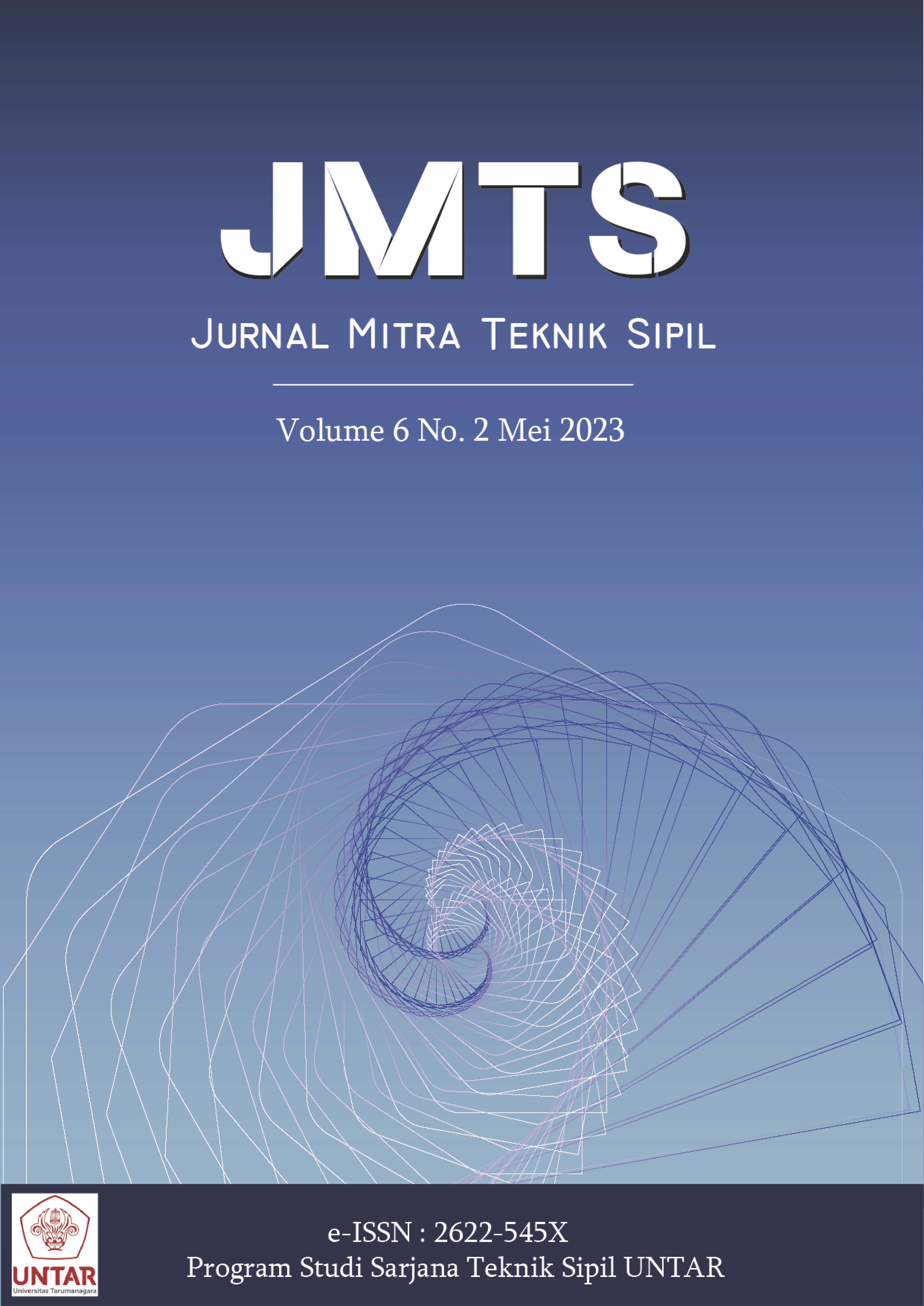ANALISIS JUMLAH CARBON FOOTPRINT SEMEN PADA PEKERJAAN PLESTER DINDING PROYEK RUMAH TINGGAL
Main Article Content
Abstract
In the world of construction, Occupational Health, Safety and Environment (OHS) is very important to do, and in OHS it is not only the occupational health and safety of construction workers that comes first. Environmental health also needs to be considered. One of the environmental pollution that occurs in construction is the carbon footprint. Carbon footprint is greenhouse gas emissions obtained from the calculation of carbon dioxide (CO2) emissions. The ongoing carbon footprint is causing global warming to hit the earth. The process of making cement to managing cement into residential wall plaster, causing carbon footprint. Carbon footprint is reviewed from the cement manufacturing process, cement transportation process, to the management process into residential cement wall plaster. The purpose of this study is to be able to calculate the amount of carbon dioxide (CO2) gas on the plastering of the walls of a residential house. There are differences and deviations in the thickness of the plastering of the walls of each house, therefore the analysis will compare the results of the differences in the thickness of the wall plaster. From the results of the analysis conducted on 5 different houses located in Sunter, North Jakarta, there were only 2 houses that met the threshold value standard of 5.000 ppm or 0,005 Tons / m3. The average emission result for 5 residential projects if the difference in cement wall plaster thickness is not taken into account is 0,005242 Tons / m3, while in reality on the ground it is 0,005381 Tons / m3.
Abstrak
Dalam dunia konstruksi Keselamatan, Kesehatan Kerja dan Lingkungan (K3L) sangat penting untuk dilakukan, dan dalam K3L bukan hanya kesehatan dan keselamatan kerja para pekerja konstruksi saja yang diutamakan. Kesehatan lingkungan juga perlu untuk diperhatikan. Pencemaran lingkungan yang terjadi dalam konstruksi salah satunya adalah carbon footprint. Carbon footprint merupakan emisi gas rumah kaca yang didapatkan dari perhitungan emisi gas karbon dioksida (CO2). Carbon footprint yang sedang berlangsung menyebabkan pemanasan global yang melanda bumi. Proses pembuatan semen sampai dengan pengelolaan semen menjadi plesteran rumah tinggal, menimbulkan carbon footprint. Carbon footprint ditinjau dari proses pembuatan semen, proses transportasi semen, sampai dengan proses pengelolaan menjadi plesteran rumah tinggal. Tujuan dalam penelitian ini untuk dapat menghitung jumlah gas karbon dioksida (CO2) pada plesteran dinding rumah tinggal. Terdapat adanya perbedaan dan penyimpangan ketebalan plesteran dinding dari tiap masing-masing rumah, oleh karena itu analisis akan membandingkan hasil akibat dari adanya perbedaan dari ketebalan plesteran. Dari hasil analisis yang dilakukan terhadap 5 rumah yang berbeda yang terletak di Sunter Jakarta Utara, hanya terdapat 2 rumah yang memenuhi standar nilai ambang batas sebesar 5.000 ppm atau 0,005 Ton/m3. Hasil rata-rata emisi untuk 5 proyek rumah tinggal jika perbedaan tebal plesteran tidak diperhitungkan adalah sebesar 0,005242 Ton/m3, sedangkan pada kenyataan di lapangan adalah sebesar 0,005381 Ton/m3.
Article Details

This work is licensed under a Creative Commons Attribution-NonCommercial-ShareAlike 4.0 International License.
This work is licensed under Jurnal Mitra Teknik Sipil (JMTS) Creative Commons Attribution-ShareAlike 4.0 International License.References
Aditama, S. K. (2021). Analisis Konsumsi Embodied Energy dan Embodied Carbon pada Material Bangunan Rumah Sederhana Tipe 36. Jurnal Teknik Vol. 42 No. 2, 160-168.
abara, W. K., Nasirudin, & Sriwinarno, H. (2018). Identifikasi dan Analisis Jejak Karbon (Carbon Footprint ) Dari Penggunaan Listrik di Institut Teknologi Yogyakarta. Jurnal Rekayasa Lingkungan Vol.8 No. 2, 1-9.
Ahmed, E. B. (2020). Testing the Effect of Building Materials on Carbon Footprints. International Journal of Engineering Science Invention (IJESI) Vol.9, 35-41.
Hanafiah, Y. (2019). Analisis Material Waste Pada Pekerjaan Plesteran Dinding [Skripsi yang dipublikasikan]. Yogyakarta: Universitas Islam Indonesia.
Hardiningtyas, P. R. (2016). Masalah Tanah dan Krisis Lingkungan di Bali dalam Antologi Puisi Dongeng Dari Utara Karya Made Adnyana Ole. Jurnal ATAVISME, Vol. 19, No. 1, 45-59.
Hoekstra, A. Y., & Ercin, A. E. (2012). Carbon And Water Footprint. Paris: United Nations Educational, Scientific and Cultural Organization.
Labaran, Y. H., Mathur, V. S., & Farouq, M. M. (2021). The carbon footprint of construction industry: A review of direct and indirect emission. Journal of Sustainable Construction Materials and Technologies Vol.6, 101-115.
Lapenangga, A. (2016). Perhitungan Jejak Karbon Bangunan Rumah Tinggal Tipe 45 M2 di Kota Kupang. Jogjakarta: Universitas Atma Jaya .
Meidianti, E. N. (2014). Pengaruh Penggunaan Masker Terhadap Keluhan Subjektif Tenaga Kerja Pengrajin Batu Alam di Desa Muncan Karangasem Tahun 2014. Denpasar: Politeknik Kesehatan Denpasar.
Mindess, S., Francis, J. Y., & Darwin, D. (1989). Concrete Second Edition. California: Prentice Hall, Pearson Education, Inc. Upper Saddle River.
Mubarak, A., & Rahman, I. (2020). A Comparative Analysis of Carbon Emissions from Transportation and Logistics of the Consumer Goods Industry in Southeast Asia. International Journal of Technology Vol.11 No.2, 333-341.
Nugrahardani, A., Jatmiko, I., Wibowo, A. M., & Budieny, H. (2017). Evaluasi Material Waste Dan Carbon Footprint Pada Penerapan Green Construction. Jurnal Karya Teknik Sipil Vol 6 no.1, 375- 384.
Postnote. (2006). Carbon footprint of electricity generation. Parliamentary Office of Science and Technology, 1-4.
Worrell, E., Price, L., Martin, N., Hendriks, C., & Meida, L. O. (2001). Carbon Dioxide Emissions From The Global Cement Industry. Annu. Rev. Energy Environ Journal, 303-329.
Zainordin, N., & Zahra, D. B. (2020). Factors Contributing to Carbon Emission in Construction Activity. Advances in Engineering Research Journal Vol.200, 176-182.



